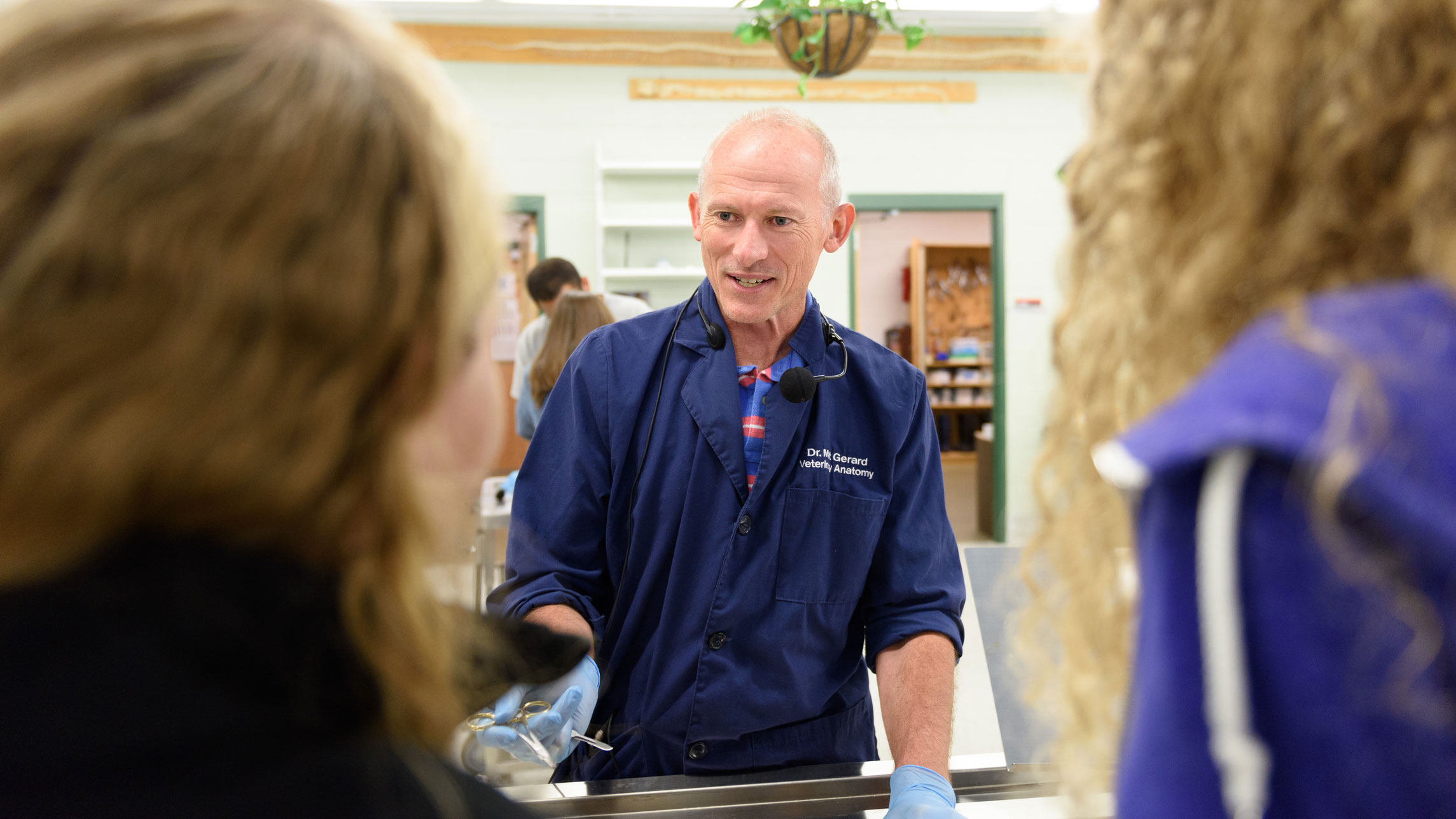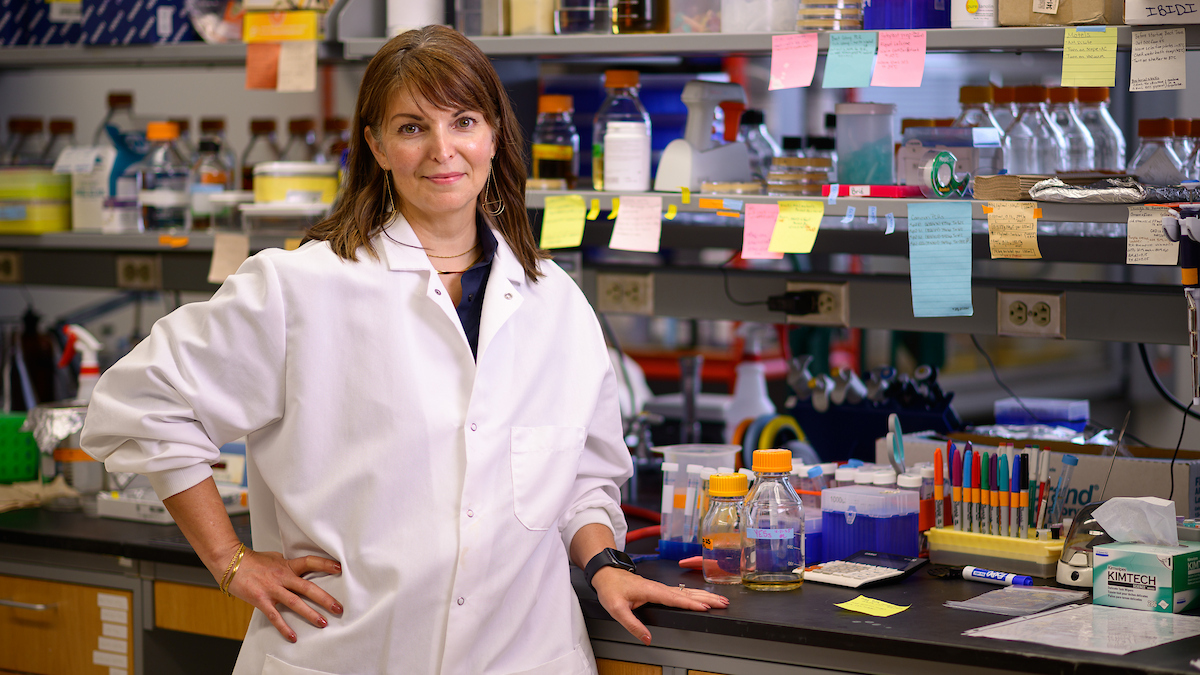CVM’s Mat Gerard Receives NC State Outstanding Teacher Award

When Mathew Gerard’s your teacher, you get all of him.
If, like Gabriel Gonzalez, you’re studying in the library late at night before a major anatomy exam, you’ll watch as Gerard goes desk to desk, student to student, just to see if there are any last-minute questions he can help with.
When Gonzalez, now a third-year NC State College of Veterinary Medicine student, struggled in his first small animal veterinary anatomy course, Gerard met him and others students for informal tutoring sessions. Later, when Gonzalez become an anatomy teaching assistant, Gerard became a mentor, encouraging him as he developed his own teaching materials.
And, in that first difficult year of veterinary school, when Gonzalez’s grandfather died, Gerard wrote him to offer his condolences. Gerard not only sparked Gonzalez’ passion for equine surgery, but showed him, over and over again, what it really means for an educator to be truly, deeply invested in their students.
“He not only cares about the quality of education of the student, but he recognizes that the education is not possible without the student’s mental wellness being a good state,” said Gonzalez
Gerard, who first came to to the CVM in 2001 as a clinical assistant professor of large animal surgery before becoming a veterinary anatomy professor in 2012, is one of this year’s campus-wide winners of NC State’s Outstanding Teacher Award. He’ll be honored at a ceremony in April.
The award is a testament to Gerard’s far-ranging and unceasing impact at the CVM. Every student knows Gerard, and he knows them. He typically welcomes them by name during the white coat ceremony the summer before they enter the CVM, and he is almost always there to see them off during graduation four years later.
Every 100-member class must take his anatomy course, and it’s a course they have been warned about from others as tough or unbearable or other even less desirable adjectives. The anatomy course content has been reinvigorated under his leadership, with students and colleagues now giving it high marks.
Gerard has also developed a range of selectives, focus-area classes that offer additional student training, that include such topics as equine dentistry and effective communication. He is consistently part of student life, heavily involved in the CVM’s Student American Veterinary Medical Association and CVM committees on diversity, inclusion and wellness.
“There’s a lot of ways to be in that giving back mentality. For me, it happens to be teaching,” said Gerard. “Wanting to help in some way seems to always be there. I need to contribute. It’s a huge responsibility and it’s a huge challenge and it’s incredibly rewarding.”
In their joint letter nominating Gerard for the teaching award, Laura Nelson, associate dean and director of academic affairs, and Barbara Sherry, the head of molecular biomedical sciences, Gerard’s department, emphasized Gerard’s talent as an educator, as well as the humility and kindness he displays to both students and peers. He has won numerous awards as a surgeon and a teacher, they noted, but what makes Gerard extraordinary is how he effortlessly connects with so many people every day.
“Between the lines of his curriculum vitae and list of accomplishments are the lives that he has affected and the curricula that he has been instrumental in improving,” Nelson and Sherry wrote.
Gerard is an advocate and a friend, a motivator. Where many speak first and think afterwards, Gerard listens and considers. He’s the one who helps build consensus when the gap between viewpoints is frustratingly large.
The one word he uses to best describe his teaching style is empathy. What he really hopes for every student is that they are good citizens — thoughtful, helpful, considerate.
“When I get up each day and when I walk into this building, my intent is to make a positive difference,” said Gerard. “That’s my role as an instructor.”
A native Australian, Gerard’s parents — his father was a doctor and his mother was a nurse — who taught him and his siblings the value of hard work and the power of basic decency. He was trained in large animal medicine and surgery as an intern and resident before earning a Ph.D. in equine exercise physiology.
That’s what he was hired to do at the CVM — large animal surgery — and that’s what he did for 11 years. Then, in a rare move for a successful surgeon, he left the clinics to become a full-time anatomy professor. On the clinical team, he often worked with small groups of students. Now, he could reach an entire class at a time. That whole decision, he said, came down to the fact that he simply loves teaching.
And he loves improving himself as an educator. Every semester, he revisits his anatomy course and thinks about how to improve student success and advance his techniques. He will walk out of an education seminar and the next day apply something he just learned to his lecture.
His teaching style impacts his colleagues, who are often become friends. Liara Gonzalez, assistant professor of gastroenterology and equine surgery, met Gerard in 2007 when he helped train her as a large animal surgeon.
“I was always amazed at his ability to patiently and calmly guide and instruct me through difficult surgeries,” wrote Gonzalez in her nomination letter. “He created an environment that fostered learning. He never made anyone feel inadequate for not knowing the answer or for making a mistake. “
Christopher Walker, assistant professor of anatomy, wrote in his nomination letter that he has modeled his own teaching style on Gerard’s.
“Never before in my academic career, as a student or faculty member, have I worked with or learned from an individual more patient, respectful, knowledgeable, enthusiastic and committed to the practice of teaching than Dr. Gerard,” wrote Walker.
Gerard remembered when people questioned why he wanted to start teaching anatomy in the first place. Why, they asked, would he want to go from being a top equine surgeon, in the thick of clinical adrenaline rushes and at the forefront of new medical technologies, to teaching what they called a “dead subject.” The material will be the same one year to the next and to the next, they told him.
“I never considered anatomy to be a subject that would never be stimulating to me. And I always thought that it could be stimulating to students,” Gerard said, quietly but forcefully.
The science of veterinary anatomy may not change. Thankfully, neither will Gerard.
~Jordan Bartel/ NC State Veterinary Medicine


